Fast-food restaurant: Difference between revisions
→Trends: deleted text about starlink - recalled shells were from supermarkets, not restaurants. not a fast food issue per se |
|||
| Line 108: | Line 108: | ||
===Health concerns=== |
===Health concerns=== |
||
Some of the large fast food chains are beginning to incorporate healthier alternatives in their menu, e.g., white meat, snack wraps, salads, and fresh fruit. However, some people see these moves as a [[tokenism|tokenistic]] and commercial measure, rather than an appropriate reaction to ethical concerns about the world [[ecology]] and people's [[health]]. McDonald's announced that in March 2006, the chain would include nutritional information on the packaging of all of its products.<ref>http://media.www.theeagleonline.com/media/storage/paper666/news/2005/11/03/News/Mcdonalds.Nutrition.Facts.To.Be.On.Food.Packaging.By.2006-1043893.shtml</ref> |
Some of the large fast food chains are beginning to incorporate healthier alternatives in their menu, e.g., white meat, snack wraps, salads, and fresh fruit. However, some people see these moves as a [[tokenism|tokenistic]] and commercial measure, rather than an appropriate reaction to ethical concerns about the world [[ecology]] and people's [[health]]. McDonald's announced that in March 2006, the chain would include nutritional information on the packaging of all of its products.<ref>http://media.www.theeagleonline.com/media/storage/paper666/news/2005/11/03/News/Mcdonalds.Nutrition.Facts.To.Be.On.Food.Packaging.By.2006-1043893.shtml</ref> |
||
In September 2000, up to $50 million worth of [[Taco Bell GMO recall|Taco Bell's shells were recalled]] from its restaurants as well as supermarkets. The shells contained [[Genetically modified maize|genetically modified corn]] that was deemed unfit for human consumption by the [[Food and Drug Administration]] (FDA). It was the first-ever recall of a genetically modified food. The environmental group [[Friends of the Earth]] that had first detected the contaminated shells was critical of the FDA for not doing its own job. |
|||
===Consumer appeal=== |
===Consumer appeal=== |
||
Revision as of 16:28, 14 September 2013

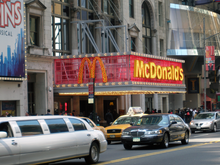
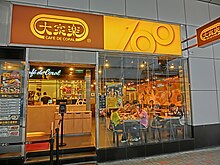
A fast food restaurant, also known as a quick service restaurant (QSR) within the industry, is a specific type of restaurant characterized both by its fast food cuisine and by minimal table service. Food served in fast food restaurants typically caters to a "meat-sweet diet" and is offered from a limited menu; is cooked in bulk in advance and kept hot; is finished and packaged to order; and is usually available ready to take away, though seating may be provided. Fast food restaurants are typically part of a restaurant chain or franchise operation, which provisions standardized ingredients and/or partially prepared foods and supplies to each restaurant through controlled supply channels. The term "fast food" was recognized in a dictionary by Merriam–Webster in 1951.[1]
Arguably, the first fast food restaurants originated in the United States with A&W in 1919 and White Castle in 1921.[2] Today, American-founded fast food chains such as McDonald's and KFC are multinational corporations with outlets across the globe.
Variations on the fast food restaurant concept include fast casual restaurants and catering trucks. Fast casual restaurants have higher sit-in ratios, and customers can sit and have their orders brought to them. Catering trucks often park just outside worksites and are popular with factory workers.
History
The examples and perspective in this article may not represent a worldwide view of the subject. (April 2012) |
United States
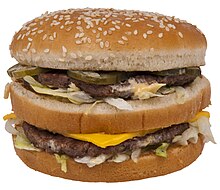

Some trace the modern history of fast food in America to July 7, 1912, with the opening of a fast food restaurant called the Automat in New York. The Automat was a cafeteria with its prepared foods behind small glass windows and coin-operated slots. Joseph Horn and Frank Hardart had already opened the first Horn & Hardart Automat in Philadelphia in 1902, but their “Automat” at Broadway and 13th Street, in New York City, created a sensation. Numerous Automat restaurants were built around the country to deal with the demand. Automats remained extremely popular throughout the 1920s and 1930s. The company also popularized the notion of “take-out” food, with their slogan “Less work for Mother”.
Some historians and secondary school textbooks concur that A&W, which opened in 1919 and began franchising in 1921, was the first fast food restaurant (E. Tavares). Thus, the American company White Castle is generally credited with opening the second fast-food outlet in Wichita, Kansas in 1921, selling hamburgers for five cents apiece from its inception and spawning numerous competitors and emulators. What is certain, however, is that White Castle made the first significant effort to standardize the food production in, look of, and operation of fast-food hamburger restaurants. William Ingram's and Walter Anderson's White Castle System created the first fast food supply chain to provide meat, buns, paper goods, and other supplies to their restaurants, pioneered the concept of the multistate hamburger restaurant chain, standardized the look and construction of the restaurants themselves, and even developed a construction division that manufactured and built the chain's prefabricated restaurant buildings. The McDonalds' Speedee Service System and, much later, Ray Kroc's McDonald's outlets and Hamburger University all built on principles, systems and practices that White Castle had already established between 1923 and 1932.
The hamburger restaurant most associated by the public with the term "fast food" was created by two brothers originally from Nashua, New Hampshire. Richard and Maurice McDonald opened a barbecue drive-in in 1940 in the city of San Bernardino, California. After discovering that most of their profits came from hamburgers, the brothers closed their restaurant for three months and reopened it in 1948 as a walk-up stand offering a simple menu of hamburgers, french fries, shakes, coffee, and Coca-Cola, served in disposable paper wrapping. As a result, they could produce hamburgers and fries constantly, without waiting for customer orders, and could serve them immediately; hamburgers cost 15 cents, about half the price at a typical diner. Their streamlined production method, which they named the "Speedee Service System" was influenced by the production line innovations of Henry Ford.
By 1954, The McDonald brothers' stand was restaurant equipment manufacturer Prince Castle's biggest purchaser of milkshake blending machines. Prince Castle salesman Ray Kroc traveled to California to discover why the company had purchased almost a dozen of the units as opposed to the normal one or two found in most restaurants of the time. Enticed by the success of the McDonald's concept, Kroc signed a franchise agreement with the brothers and began opening McDonald's restaurants in Illinois.[3] By 1961, Kroc had bought out the brothers and created what is now the modern McDonald's Corporation. One of the major parts of his business plan was to promote cleanliness of his restaurants to growing groups of Americans that had become aware of food safety issues. As part of his commitment to cleanliness, Kroc often took part in cleaning his own Des Plaines, Illinois outlet by hosing down the garbage cans and scraping gum off the cement. Another concept Kroc added was great swaths of glass which enabled the customer to view the food preparation, a practice still found in chains such as Krispy Kreme. A clean atmosphere was only part of Kroc's grander plan which separated McDonald's from the rest of the competition and attributes to their great success. Kroc envisioned making his restaurants appeal to suburban families.[4]
At roughly the same time as Kroc was conceiving what eventually became McDonald's Corporation, two Miami, Florida businessmen, James McLamore and David Edgerton, opened a franchise of the predecessor to what is now the international fast food restaurant chain Burger King. McLamore had visited the original McDonald's hamburger stand belonging to the McDonald brothers; sensing potential in their innovative assembly line-based production system, he decided he wanted to open a similar operation of his own.[5][6] The two partners eventually decided to invest their money in Jacksonville, Florida-based Insta-Burger King. Originally opened in 1953, the founders and owners of the chain, Kieth J. Kramer and his wife's uncle Matthew Burns, opened their first stores around a piece of equipment known as the Insta-Broiler. The Insta-Broiler oven proved so successful at cooking burgers, they required all of their franchises to carry the device.[5] By 1959 McLamore and Edgarton were operating several locations within the Miami-Dade area and were growing at a fast clip. Despite the success of their operation, the partners discovered that the design of the insta-broiler made the unit's heating elements prone to degradation from the drippings of the beef patties. The pair eventually created a mechanized gas grill that avoided the problems by changing the way the meat patties were cooked in the unit. After the original company began to falter in 1959, it was purchased by McLamore and Edgerton who renamed the company Burger King.[7]
While fast food restaurants usually have a seating area in which customers can eat the food on the premises, orders are designed to be taken away, and traditional table service is rare. Orders are generally taken and paid for at a wide counter, with the customer waiting by the counter for a tray or container for their food. A "drive-through" service can allow customers to order and pick up food from their cars.
Nearly from its inception, fast food has been designed to be eaten "on the go" and often does not require traditional cutlery and is eaten as a finger food. Common menu items at fast food outlets include fish and chips, sandwiches, pitas, hamburgers, fried chicken, french fries, chicken nuggets, tacos, pizza, and ice cream, although many fast food restaurants offer "slower" foods like chili, mashed potatoes, and salads.
Cuisine
Modern commercial fast food is highly processed and prepared on a large scale from bulk ingredients using standardized cooking and production methods and equipment. It is usually rapidly served in cartons or bags or in a plastic wrapping, in a fashion which reduces operating costs by allowing rapid product identification and counting, promoting longer holding time, avoiding transfer of bacteria, and facilitating order fulfillment. In most fast food operations, menu items are generally made from processed ingredients prepared at a central supply facilities and then shipped to individual outlets where they are cooked (usually by grill, microwave, or deep-frying) or assembled in a short amount of time either in anticipation of upcoming orders (i.e., "to stock") or in response to actual orders (i.e., "to order"). Following standard operating procedures, pre-cooked products are monitored for freshness and disposed of if holding times become excessive. This process ensures a consistent level of product quality, and is key to delivering the order quickly to the customer and avoiding labor and equipment costs in the individual stores.
Because of commercial emphasis on taste, speed, product safety, uniformity, and low cost, fast food products are made with ingredients formulated to achieve an identifiable flavor, aroma, texture, and "mouth feel" and to preserve freshness and control handling costs during preparation and order fulfillment. This requires a high degree of food engineering. The use of additives, including salt, sugar, flavorings and preservatives, and processing techniques may limit the nutritional value of the final product.
Value meals
A value meal is a group of menu items offered together at a lower price than they would cost individually. They are common at fast food restaurants. Value meals are a common merchandising tactic to facilitate bundling, up-selling, and price discrimination. Most of the time they can be upgraded to a larger size of fries and drink for a small fee. The perceived creation of a "discount" on individual menu items in exchange for the purchase of a "meal" is also consistent with the loyalty marketing school of thought.[8]
Technology
To make quick service possible and to ensure accuracy and security, many fast food restaurants have incorporated hospitality point of sale systems. This makes it possible for kitchen crew people to view orders placed at the front counter or drive through in real time. Wireless systems allow orders placed at drive through speakers to be taken by cashiers and cooks. Drive through and walk through configurations will allow orders to be taken at one register and paid at another. Modern point of sale systems can operate on computer networks using a variety of software programs. Sales records can be generated and remote access to computer reports can be given to corporate offices, managers, troubleshooters, and other authorized personnel.
Food service chains partner with food equipment manufacturers to design highly specialized restaurant equipment, often incorporating heat sensors, timers, and other electronic controls into the design. Collaborative design techniques, such as rapid visualization and parametric modeling of restaurant kitchens are now being used to establish equipment specifications that are consistent with restaurant operating and merchandising requirements.[9]
Business
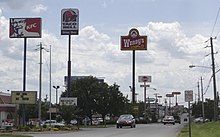
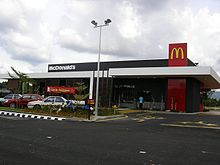
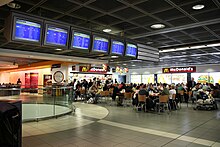
Consumer spending
In the United States, consumers spent about $110 billion on fast food in 2000 (which increased from $6 billion in 1970).[10] The National Restaurant Association forecasts that fast food restaurants in the US will reach $142 billion in sales in 2006, a 5% increase over 2005. In comparison, the full-service restaurant segment of the food industry is expected to generate $173 billion in sales. Fast food has been losing market share to so-called fast casual restaurants, which offer more robust and expensive cuisines.
Major international brands
McDonald's, a fast food supplier, opened its first franchised restaurant in the US in 1955 (1974 in the UK). It has become a phenomenally successful enterprise in terms of financial growth, brand-name recognition, and worldwide expansion. Ray Kroc, who bought the franchising license from the McDonald brothers, pioneered concepts which emphasized standardization. He introduced uniform products, identical in all respects at each outlet, to increase sales. Kroc also insisted on cutting food costs as much as possible, eventually using the McDonald's Corporation's size to force suppliers to conform to this ethos.
Other prominent international fast food companies include Burger King, the number two hamburger chain in the world, known for promoting its customized menu offerings (Have it Your Way).
Multinational corporations typically modify their menus to cater to local tastes, and most overseas outlets are owned by native franchisees. McDonald's in India, for example, uses chicken and paneer rather than beef and pork in their burgers because Hinduism traditionally forbids eating beef. In Israel some McDonald's restaurants are kosher and respect the Jewish Shabbat; there is also a kosher McDonald's in Argentina. In Egypt, Morocco, Saudi Arabia, Malaysia, and Singapore, all menu items are halal.
North America

Many fast food operations have more local and regional roots, such as White Castle in the Midwest United States, along with Hardee's (owned by CKE Restaurants, which also owns Carl's Jr., whose locations are primarily on the United States West Coast); Krystal, Bojangles' Famous Chicken 'n Biscuits, Cook Out, and Zaxby's restaurants in the American Southeast; Raising Cane's in Louisiana; Hot 'n Now in Michigan and Wisconsin; In-N-Out Burger (in California, Arizona, Nevada, Utah, and Texas) and Original Tommy's chains in Southern California; Dick's Drive-In in Seattle, Washington and Arctic Circle in Utah and other western states; Halo Burger around Flint, Michigan and Burgerville in the Portland, Oregon area. Also, Whataburger is a popular burger chain in the American South and Mexico, and Jack in the Box is located in the West and South. Canada pizza chains Topper's Pizza and Pizza Pizza are primarily located in Ontario. Coffee chain Country Style operates only in Ontario, and competes with the famous coffee and donut chain Tim Hortons. Maid-Rite restaurant is one of the oldest chain fast food restaurants in the United States. Founded in 1926, their specialty is a loose meat hamburger. Maid-Rites can be found in the midwest - mainly Iowa, Minnesota, Illinois, and Missouri.
International brands dominant in North America include McDonald's, Burger King and Wendy's, the number three burger chain in the USA; Dunkin' Donuts, a New England-based chain; automobile oriented Sonic Drive-In's from Oklahoma City; Starbucks, Seattle-born coffee-based fast food beverage corporation; KFC, a part of the largest restaurant conglomerate in the world, Yum! Brands; and Domino's Pizza, a pizza chain known for popularizing home delivery of fast food.
Subway is known for their sub sandwiches and are the largest restaurant chain to serve such food items.[11] Quiznos a Denver-based sub shop is another fast-growing sub chain, yet with over 6,000 locations it is still far behind Subway's 34,000 locations. Other smaller sub shops include Blimpie, Jersey Mike's Subs, Mr. Goodcents, Jimmy John's, and Firehouse.
A&W Restaurants was originally a United States and Canada fast food brand, but it is currently an International fast food corporation in several countries.
In Canada the majority of fast food chains are American owned or were originally American owned but have since set up a Canadian management/headquarters location in cities such as Toronto and Vancouver such as Panera Bread, Chipotle Mexican Grill, Five Guys, Carl's Jr. and Chili's. Although the case is usually American fast food chains expanding into Canada, Canadian chains such as Tim Hortons have expanded into 22 states in the United States, but are more prominent in border states such as New York and Michigan. Tim Hortons has started to expand to other countries outside of North America. The Canadian Extreme Pita franchise sells low fat and salt pita sandwiches with stores in the larger Canadian cities. Other Canadian fast food chains such as Manchu Wok serve North American style Asian foods; this company is located mainly in Canada and the USA, with other outlets on US military bases on other continents. Harvey's is a Canadian-only burger restaurant chain, present in every province except Newfoundland and Labrador.
The United Kingdom
In the United Kingdom, many home based fast food operations were closed in the 1970s and 1980s after McDonald's became the number one outlet in the market[citation needed]. However, brands like Wimpy still remain, although the majority of branches became Burger King in 1989.
Japan
Traditional ramen and sushi restaurants still dominate fast food culture in Japan, although American outlets like Pizza Hut, McDonald's, and KFC are also popular, along with Japanese chains like MOS Burger.
India
The major fast food chains in India are KFC, McDonalds, Subway, Pizza Hut, and Dominos. These chains provide mostly western products. However most Indians prefer the local cuisine such as samosas, panipuri, pav Bhaji etc. Major emerging food chains include Haldiram's and Café Coffee Day.
Nigeria
In Nigeria, Mr. Bigg's, Chicken Republic, Tantalizers, and Tastee Fried Chicken are the predominant fast food chains. KFC and Pizza Hut have recently entered the country.
Pakistan
Fast food In Pakistan varies. There are many international chains serving fast food, including Nandos, KFC, McDonalds, Dunkin' Donuts, Subway, Pizza Hut, Hardees, Telepizza and Gloria Jean's Coffees. In addition to the international chains, in local cuisine people in Pakistan like to have biryani, bun kebabs, Nihari, kebab rolls etc. as fast food.
South Africa
KFC is the most popular fast food chain in South Africa according to a 2010 Sunday Times survey.[12] Chicken Licken, Wimpy and Ocean Basket along with Nando's and Steers are examples of homegrown franchises that are highly popular within the country. McDonalds, Subway and Pizza Hut have a significant presence within South Africa.
Hong Kong
In Hong Kong, although McDonald's and KFC are quite popular, 3 major local fast food chains provide Hong Kong Chinese style fast food, namely Café de Coral, Fairwood Fast Food, and Maxim MX.
Israel
In Israel, local burger chain Burger Ranch is popular as are McDonald's, Burger King and KFC. Domino's Pizza is also a popular fast food restaurant. Chains like McDonalds offer kosher branches. Non-kosher foods such as cheeseburgers are rare in Israeli fast food chains, even in non-kosher branches. There are many small local fast food chains that serve pizza, burgers and local foods such as falafel.
New Zealand
In New Zealand, the fast food market began in the 1970s with KFC (opened 1971), Pizza Hut (1974), and McDonald's (1976),[13] and all three remain popular today. Burger King and Domino's entered the market later in the 1990s. Australian pizza chains Eagle Boys and Pizza Haven also entered the market in the 1990s, but their New Zealand operations were later sold to Pizza Hut and Domino's.
A few fast food chains have been founded in New Zealand, including Burger Fuel (founded 1995), Georgie Pie (founded 1977, but closed 1998 after falling into financial trouble and being bought out by McDonald's) and Hell Pizza (founded 1996).
Philippines
In the Philippines, fast-food is the same as in the US. However, the only difference is that they serve Filipino dishes and a few American products being served Filipino-style.
Trends
Health concerns
Some of the large fast food chains are beginning to incorporate healthier alternatives in their menu, e.g., white meat, snack wraps, salads, and fresh fruit. However, some people see these moves as a tokenistic and commercial measure, rather than an appropriate reaction to ethical concerns about the world ecology and people's health. McDonald's announced that in March 2006, the chain would include nutritional information on the packaging of all of its products.[14]
In September 2000, up to $50 million worth of Taco Bell's shells were recalled from its restaurants as well as supermarkets. The shells contained genetically modified corn that was deemed unfit for human consumption by the Food and Drug Administration (FDA). It was the first-ever recall of a genetically modified food. The environmental group Friends of the Earth that had first detected the contaminated shells was critical of the FDA for not doing its own job.
Consumer appeal

Fast food outlets have become popular with consumers for several reasons. One is that through economies of scale in purchasing and producing food, these companies can deliver food to consumers at a very low cost. In addition, although some people dislike fast food for its predictability, it can be reassuring to a hungry person in a hurry or far from home [citation needed]
In the post-World War II period in the United States, fast food chains like McDonald's rapidly gained a reputation for their cleanliness, fast service, and a child-friendly atmosphere where families on the road could grab a quick meal, or seek a break from the routine of home cooking[citation needed]. Prior to the rise of the fast food chain restaurant, people generally had a choice between greasy spoon diners where the quality of the food was often questionable and service lacking, or high-end restaurants that were expensive and impractical for families with children[citation needed]. The modern, stream-lined convenience of the fast food restaurant provided a new alternative and appealed to Americans' instinct for ideas and products associated with progress, technology, and innovation.[citation needed] Fast food restaurants rapidly became the eatery "everyone could agree on", with many featuring child-size menu combos, play areas, and whimsical branding campaigns, like the iconic Ronald McDonald, designed to appeal to younger customers. Parents could have a few minutes of peace while children played or amused themselves with the toys included in their Happy Meal. There is a long history of fast food advertising campaigns, many of which are directed at children.
In other parts of the world, American and American-style fast food outlets have been popular for their quality, customer service, and novelty, even though they are often the targets of popular anger towards American foreign policy or globalization more generally[citation needed]. Many consumers nonetheless see them as symbols of the wealth, progress, and well-ordered openness of Western society and therefore become trendy attractions in many cities around the world, particularly among younger people with more varied tastes. [citation needed]
Impact of fast food restaurant availability
Over time, fast food restaurants have been growing rapidly, especially in urban neighborhoods. According to US research, low-income and predominantly African-American neighborhoods have greater exposure to fast food outlets than higher income and predominantly white areas. [15] This has put into question whether urbanized neighborhoods were targeted, which causes a more unhealthy group of people compared to people from a higher socioeconomic status. It has also been shown that there is a lower chance of finding a fast food restaurant in a suburban neighborhood. In a study of selected US locations, Morland et al. (2002) found the number of fast food restaurants and bars was inversely proportional to the wealth of the neighborhood, and that predominantly African-American residential areas were four times less likely to have a supermarket near them than predominantly white areas.[16]
Innovations timeline
- 1872: Walter Scott of Providence, RI outfitted a horse-drawn lunch wagon with a simple kitchen, bringing hot dinners to workers[17]
- 1902: First Horn & Hardart Automat opened in Philadelphia
- 1912: Horn & Hardart opens a second Automat in Manhattan
- 1916: Walter Anderson built the first White Castle in Wichita, KS in 1916, introducing the limited menu, high volume, low cost, high speed hamburger restaurant[17]
- 1919: A&W Root Beer took its product out of the soda fountain and into a roadside stand[17]
- 1921: A&W Root Beer began franchising its syrup[17]
- 1921: White Castle opens its first restaurant
- 1926: Maid-Rite opened its first restaurant in Muscatine, Iowa.
- 1930s: Howard Johnson's pioneered the concept of franchising restaurants, formally standardizing menus, signage, and advertising[17]
- 1948: In-N-Out Burger begins drive-through service utilizing call-box technology
- 1967: McDonald's opens its first restaurants outside the US.[1]
- 1971: McDonald's begins serving breakfast, test-marketing the Egg McMuffin in the US.[2]
- 1971: The first Starbucks store opens in Seattle, Washington in Pike Place Market to sell high-quality coffee beans and equipment
- 1980: 7-Eleven introduces the 32-US-fluid-ounce (950 ml) Big Gulp
- 1981: Arby's offers nutritional information
- 1987: Howard Schultz leads purchase of the Starbucks brand from its founders (who adopted the name Peet's) and begins offering coffee drinks modeled after those sold in Italian coffee bars
- 1994: McDonald's begins "supersizing" Extra Value Meals
- 1994: Arctic Circle becomes the first fast food restaurant to sell Angus beef exclusively.
- 1994: Arby's is first fast food restaurant to implement a no-smoking policy
- 2002: McDonald's cuts back on the amount of trans fat by 48 percent on french fries
- 2006: Arby's begins elimination of trans fat oils in french fries
Criticisms
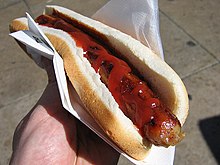
The fast food industry is a popular target for critics, from anti-globalization activists like José Bové to vegetarian activist groups such as PETA.
In his best-selling 2001 book Fast Food Nation, investigative journalist Eric Schlosser leveled a broad, socioeconomic critique against the fast food industry, documenting how fast food rose from small, family-run businesses (like the McDonald brothers' burger joint) into large, multinational corporate juggernauts whose economies of scale radically transformed agriculture, meat processing, and labor markets in the late twentieth century. Schlosser argues that while the innovations of the fast food industry gave Americans more and cheaper dining options, it has come at the price of destroying the environment, economy, and small-town communities of rural America while shielding consumers from the real costs of their convenient meal, both in terms of health and the broader impact of large-scale food production and processing on workers, animals, and land.
The fast food industry is popular in the United States, the source of most of its innovation, and many major international chains are based there. Seen as symbols of US dominance and perceived cultural imperialism, American fast food franchises have often been the target of Anti-globalization protests and demonstrations against the US government. In 2005, for example, rioters in Karachi, Pakistan, who were initially angered because of the bombing of a Shiite mosque, destroyed a KFC restaurant.[18]
Legal issues
In 2003, McDonald's was sued in a New York court by a family who claimed that the restaurant chain was responsible for their teenage daughter's obesity and attendant health problems. By manipulating food's taste, sugar and fat content, and directing their advertising to children, the suit argued that the company purposely misleads the public about the nutritional value of its product. A judge dismissed the case, but the fast food industry disliked the publicity of its practices, particularly the way it targets children in its advertising.[19] Although further lawsuits have not materialized, the issue is kept alive in the media and political circles by those promoting the need for tort reform.[20]
In response to this, the "Cheeseburger Bill" [21] was passed by the US House of Representatives in 2004; it later stalled in the US Senate. The law was reintroduced in 2005, only to meet the same fate. This law was claimed to "[ban] frivolous lawsuits against producers and sellers of food and non-alcoholic drinks arising from obesity claims." The bill arose because of an increase in lawsuits against fast food chains by people who claimed that eating their products made them obese, disassociating themselves from any of the blame.
See also
- Charging station
- Fast food advertising
- HACCP
- List of fast food restaurants
- Mediterranean diet
- Roadhouse (facility)
- Sanitation Standard Operating Procedures
References
- ^ Jack In The-Box Inc. Fact Sheet
- ^ "The Evolution of the Quick Service Restaurant". A Management Consultant @ Large. Retrieved 2008-02-10.[unreliable source?]
- ^ Daniel Gross (1977-08-07). Forbes Greatest Business Stories (pdf). John Wiley & Sons, Inc. pp. 178–192. ISBN 0-471-19653-3. Retrieved 2008-04-17.
While most restaurants bought one or two Prince Castle Multimixers, which could mix five shakes at once, the McDonald's had purchased eight. And Kroc was curious to see what kind of operation needed the capacity to churn forty milk shakes at one time.
- ^ "Where White Tower (one of the original fast food restaurants) had tied hamburgers to public transportation and the workingman...McDonald's tied hamburgers to the car, children, and the family." (Levinstein, p.228-229)
- ^ a b Smith, Andrew F. (30 August 2006). Encyclopedia of junk food and fast food (1st ed.). Greenwood Publishing Group. pp. 27–28. ISBN 0-313-33527-3. Retrieved 2009-06-14.
- ^ Carlino, Bill (19 August 1996). "BK co-founder McLamore dead at 70". Nation's Restaurant News. Retrieved 25 January 2010.
- ^ John A. Jakle (27 March 2002). Fast Food (1st ed.). JHU Press. pp. 116–119. ISBN 0-8018-6920-X. Retrieved 2009-06-15.
{{cite book}}: Unknown parameter|coauthors=ignored (|author=suggested) (help) - ^ Super-sizing, value meals, and customer loyalty
- ^ "A Lifecycle Approach to Retail Store Development". A Management Consultant @ Large. Retrieved 2008-02-11.
- ^ Schlosser, Eric (2001). Fast Food Nation: The Dark Side of the All-American Meal. Houghton Mifflin Books. ISBN 0-395-97789-4.
- ^ Bramhall, Joe. "Doctor's Associates". Hoovers.com. Retrieved 9 March 2011.
- ^ "Fill'er up : Hot, salty, fast and filling - that's how the youth want their food". The Sunday Times. May 30, 2010. Retrieved October 7, 2010.
- ^ "Dining out - food in New Zealand - NZHistory.net.nz". Retrieved 2011-01-23.
- ^ http://media.www.theeagleonline.com/media/storage/paper666/news/2005/11/03/News/Mcdonalds.Nutrition.Facts.To.Be.On.Food.Packaging.By.2006-1043893.shtml
- ^ Smoyer-Tomic, KE; Spence, JC; Raine, KD; Amrhein, C; Cameron, N; Yasenovskiy, V; Cutumisu, N; Hemphill, E; Healy, J (2008). "The association between neighborhood socioeconomic status and exposure to supermarkets and fast food outlets". Health & place. 14 (4): 740–54. doi:10.1016/j.healthplace.2007.12.001. PMID 18234537.
- ^ Morland, K; Wing, S; Diez Roux, A; Poole, C (2002). "Neighborhood characteristics associated with the location of food stores and food service places". American journal of preventive medicine. 22 (1): 23–9. PMID 11777675.
- ^ a b c d e "A Lifecycle Approach to Retail Store Development". A Management Consultant @ Large. Retrieved 2008-02-10.
- ^ "KFC Burned During Riot In Pakistan". CBS News. 2005-05-31.
- ^ "McDonald's targeted in obesity lawsuit". BBC News. 2002-11-22. Retrieved 2010-05-02.
- ^ The Legal Underground: Fast-Food Update: Where Are the Promised Obesity Lawsuits?
- ^ "US approves 'Cheeseburger bill'". BBC News. 2004-03-12. Retrieved 2010-05-02.
Further reading
- Hogan, David. Selling 'em by the Sack: White Castle and the Creation of American Food. New York: New York University Press, 1997.
- Kroc, Ray and Anderson, Robert Grinding It Out: The Making of McDonald's. Chicago: Contemporary Books, 1977.
- Levinstein, Harvey. Paradox of Plenty: a Social History of Eating in Modern America. Berkeley: University of California P, 2003. 228-229.
- Luxenberg, Stan. Roadside Empires: How the Chains Franchised America. New York: Viking, 1985.
- Mcginley, Lou Ellen with Stephanie Spurr. "Honk for Service: A Man, A Tray and the Glory Days of the Drive-In Restaurant". Tray Days Publishing, 2004
- Schlosser, Eric. "Fast Food Nation: The Dark Side of the All American Meal" HarperCollins Publishers, 2005
- Schultz, Howard and Yang, Dori Jones. "Pour Your Heart Into It: How Starbucks Built a Company One Cup at a Time". Hyperion, 1999.
